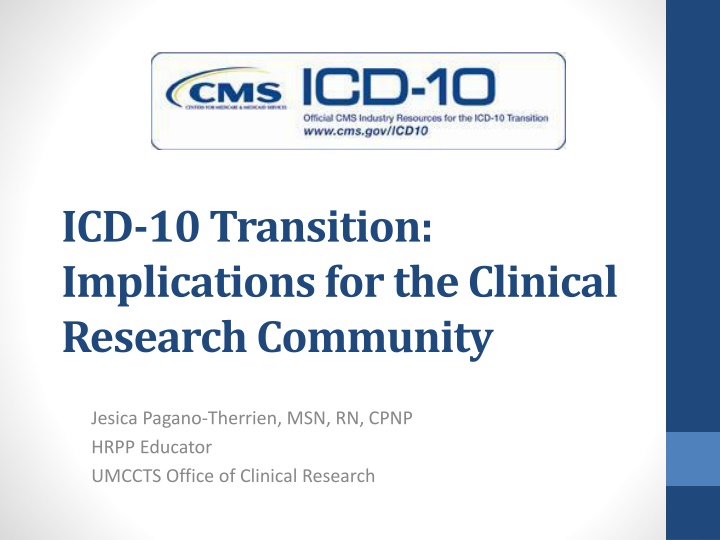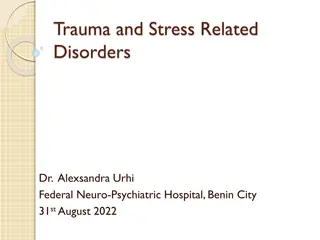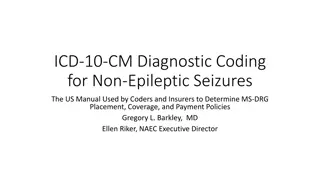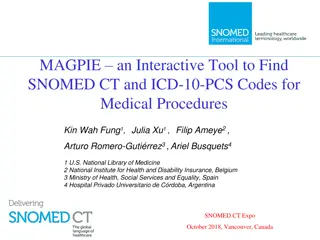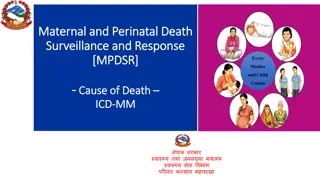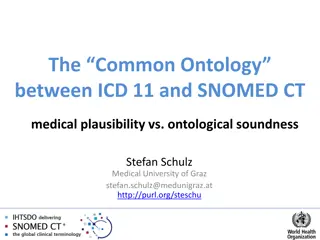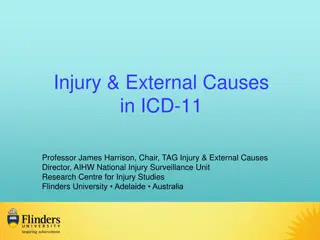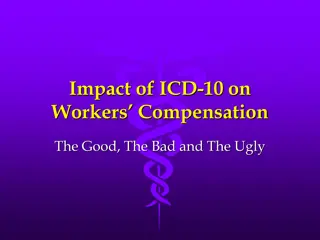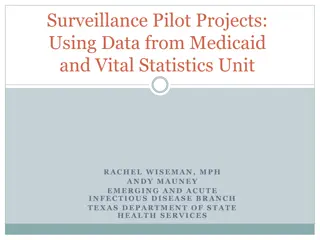ICD-10 Transition Implications for Clinical Research
Explore the transition from ICD-9 to ICD-10 and its impact on the clinical research community. Understand the benefits, implications, and structural changes of the new coding system. Learn why the shift was necessary and how it affects healthcare entities. Discover the mandate by DHHS and the introduction of ICD-10 in U.S. healthcare settings. Familiarize yourself with the code structures and differences between ICD-10 and ICD-9.
Download Presentation

Please find below an Image/Link to download the presentation.
The content on the website is provided AS IS for your information and personal use only. It may not be sold, licensed, or shared on other websites without obtaining consent from the author.If you encounter any issues during the download, it is possible that the publisher has removed the file from their server.
You are allowed to download the files provided on this website for personal or commercial use, subject to the condition that they are used lawfully. All files are the property of their respective owners.
The content on the website is provided AS IS for your information and personal use only. It may not be sold, licensed, or shared on other websites without obtaining consent from the author.
E N D
Presentation Transcript
ICD-10 Transition: Implications for the Clinical Research Community Jesica Pagano-Therrien, MSN, RN, CPNP HRPP Educator UMCCTS Office of Clinical Research
Objectives 1. To understand what ICD-10 is, and what it is used for. 2. To become familiar with the new features of ICD-10, including differences in the code structure. 3. To understand benefits of the transition to ICD-10. 4. To learn about implications of this transition for clinical research staff.
What is ICD-9? International Classification of Diseases, 9thEdition Originally designed for the purpose of comparing mortality data internationally. ICD-9-CM (clinical modification) codes classify diseases, injuries, health encounters and inpatient procedures. Federal, state, and local public health officials rely on this data for a variety of disease-related activities: Surveillance of chronic disease and injury Health care utilization Health care-associated adverse events Identify cases of reportable conditions
Why the change? ICD-9 is old. The U.S. has used ICD-9 since 1979 and many terms are now outdated. There have been many changes within medical and health care fields. Available codes do not always allow for the capture of clinically accurate data. The structure of ICD-9 codes limits the number of new codes that can be created. Most developed countries have already transitioned to ICD-10 codes.
The Department of Health and Human Services (DHHS) has mandated that all HIPAA-covered entities must transition to a new set of codes for electronic health care transactions. October 1st, 2015
Introducing.ICD-10! ICD-10-CM will be used in all U.S. health care settings. ICD-10-PCS (Procedure Coding System) will be used in U.S. inpatient hospital settings only. ICD-10 will not replace CPT codes. ICD-10 codes are diagnosis codes. CPT codes are billing codes. Per the Centers for Medicare and Medicaid Services (CMS): The transition to ICD-10 does not affect CPT coding for outpatient procedures...Like ICD-9 procedure codes, ICD-10-PCS codes are for hospital inpatient procedures only.
Code structure: Examples E11.311 Type 2 diabetes mellitus, with ophthalmic complications, with macular edema O24.012 Preexisting diabetes mellitus, Type 1, in pregnancy, 2nd trimester. Z3A.16 16 weeks gestation http://cloud.aapc.com/documents/OB- GYN-Quick-Reference_ICD-10-CM.pdf www.aafp.org
New features and additions achieve greater specificity in code assignment New clinical concepts Expansion of existing codes Injuries, diabetes, substance abuse Combination codes for conditions and commonly associated symptoms or manifestations Combination codes for poisonings and their external cause Obstetric codes that identify trimester Laterality Character x used as a placeholder to allow for future expansions of the code Exclusions Distinction between intraoperative and post-procedural complications
Benefits of ICD-10-CM Tracking public health and risks Measuring the quality, safety and efficacy of care Reducing the need for attachments to explain the patient s condition Designing payment systems and processing claims for reimbursement Conducting research, epidemiological studies and clinical trials Setting health policy Operation and strategic planning Designing health care delivery systems Monitoring resource utilization Improving clinical, financial and administrative performance Preventing and detecting health care fraud and abuse
So what WHAT DOES THIS MEAN FOR CLINICAL RESEARCH STAFF?
Implications and potential challenges for clinical research staff 1. Only covered entities must change to ICD-10; study sponsors may continue to use ICD-9. Ask any external sponsors on how they are planning for this transition in case report forms, protocols and other documents. If a protocol continues to use ICD-9, a protocol amendment to include ICD-10 codes and any associated changes to the names of specific diagnoses may help avoid an eligibility or other protocol violation.
Implications and potential challenges for clinical research staff (continued) 2. Electronic Medical Record (EMR) systems must change, but systems used in clinical research (eCRFs) may not. Know whether the research systems you use will change from ICD-9 to ICD-10. If your systems do not change, you should document how you plan to map ICD-10 codes back to ICD-9 codes. A wide variety of online tools are available to help ICD-9 to ICD-10 conversions. To look up ICD-10 codes, CMS has an online tool: https://www.cms.gov/medicare-coverage- database/staticpages/icd-10-code-lookup.aspx To perform a crosswalk, you may use sites such as https://www.aapc.com/icd-10/codes/
Implications and potential challenges for clinical research staff (continued) 3. Feasibility assessments and data mining When thinking about a potential new research study, or when you re looking at inclusion/exclusion criteria, your data mining may need to be done by both ICD-9 and ICD-10 codes. UMMS Information Technology staff are aware of this and are willing to help!
Implications and potential challenges for clinical research staff (continued) 4. Existing or longitudinal data Ensure that there is a plan in place for mapping ICD-9 to ICD- 10 codes, especially for studies that are collecting data before and after the transition.
Important code for research ICD-9 Examination of participant or control in clinical research. V70.7 ICD-10 Encounter for examination of normal comparison and control in clinical research program. Z00.6
Clinical Research coding hint 1. The reason for the experimental or investigational encounter should be the primary diagnosis. 2. The Z00.6 code is listed as the secondary diagnosis. (Gray, 2011)
Plan ahead! Discuss a transition plan with your study team and/or sponsor to avoid the 307.81! (Soon to be G44.209!)
Questions? Please review the references and resources listed on the previous slides. For questions or comments about this presentation, please email HRPeducation@umassmed.edu
References Eakin, A.D. (2014). Clinical research and ICD-10: Tools for success. Rheumatology Practice Management. Retrieved from http://rheumatologypracticemanagement.com/rpm-issues/june-2014-vol-2- no-3/2326-clinical-research-and-icd-10-tools-for-success Gray, L. (2011). ICD-10 Corner: Clinical Trial Participants. Code it right online. Retrieved from https://www.codeitrightonline.com/ciri/icd- 10-corner-clinical-trial-participants.html Vulcano,D. (2015). ICD-10 conversion and the impact on clinical research. Journal of Clinical Research Best Practices. Retrieved fromhttps://firstclinical.com/journal/2015/1501_ICD-10.pdf
Other valuable resources https://www.cms.gov/Medicare/Coding/ICD10/Downloads/ICD- 10QuickRefer.pdf http://www.cdc.gov/nchs/icd/icd10cm_pcs_background.htm
